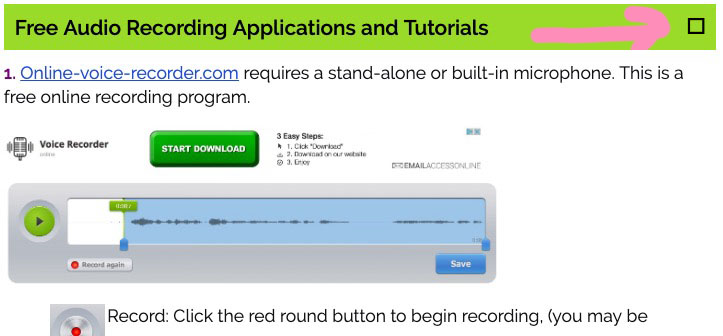Addressing Learning Barriers
Learning Objectives:
- Identify basic principles of Universal Design, Differentiated Instruction and Best Practice teaching strategies that incorporate technology resources to enhance an existing or new lesson or activity in your classroom.
"Technology has permeated all aspects of our economy and culture. Every learner now in school needs a range of literacies that are much broader and more inclusive of our changing culture. Further, an understanding of these technologies leads to a greater understanding of the possible non-tech options that can be utilized.
However, it is important to note that these technologies should not be considered to be the only way to implement UDL. Effective teachers should be creative and resourceful in designing flexible learning environments that address the variability of learners using a range of high-tech and low-tech solutions." CAST
- Be mindful when integrating the technology and the purpose of the technology in your lesson. Consider the TPACK framework.
Video (2 min), TPACK article.
In this last activity, you will take a quick look at a variety of additional tools for overcoming learning barrier.
Steps
1. Free text-to-speech converters
Below are websites that allow you to copy and paste text into them in order to hear the printed text. Some will even allow you to change the voice to be heard in a different language and give you a choice between a male or female voice. These converters are not only beneficial for those with reading difficulties, but are helpful for those who prefer to listen rather than read. They also allow writers to hear one's own pieces (or compositions) to critique for grammatical errors and comprehension.
2. Google Docs has Speech Recognition. There is an add-on when you are using the Chrome Browser on your Computer. Watch the video to learn how to use the add-on or read the step-by-step instructions.
3. Identify a Visual Tool that you could use for your lesson from this site.
4. Explore and identify an audio resource for your lesson from some of the Audio Production Resources from 21 Things 4 Students. To expand the bar to view the content select the square box on the right-hand side of it.

5. Adding Close Captions to your videos:
- 5 Speech Recognition Apps that Auto-caption Videos.
- Captioning Your Own Video for Free
- Add subtitles and captions to your YouTube videos
6. If you use the Chrome browser, explore how you can insert instructional content on any web page using Insert Learning.
7. Look over the Creating Your Digital Artifact on the 21 Things 4 Students site and see if there are some valuable additions for your lesson.
98 Complete your lesson plan template to include your graphic organizer(s) and a list of some of the resources above that you feel would be useful additions to explore. Save your lesson plan so that it can be shared with others. Include a short paragraph, or use your favorite social media tool, and share your lesson and some of the ideas and tools you feel are helpful for addressing different learning needs of students.
9. Continue on to the Final Assignment. There you will find a checklist to ensure you have completed this unit.
Standards
Addressing the ISTE Standards For Educators
Learner
1a. Set professional learning goals to explore and apply pedagogical approaches made possible by technology and reflect on their effectiveness.
1c. Stay current with research that supports improved student learning outcomes, including findings from the learning sciences.
Leader
2b. Advocate for equitable access to educational technology, digital content and learning opportunities to meet the diverse needs of all students.
2c. Model for colleagues the identification, exploration,
evaluation, curation and adoption of
new digital resources and tools for learning.
Citizen
3a. Create experiences for learners to make positive, socially responsible contributions and exhibit empathetic behavior online that build relationships and community.
3b. Establish a learning culture that promotes curiosity and critical examination of online resources and fosters digital literacy and media fluency.
3c. Mentor students in safe, legal and ethical practices with digital tools and the protection of intellectual rights and property.
Designer
5a. Use technology to create, adapt and personalize learning experiences that foster independent learning and accommodate learner differences and needs.
5b. Design authentic learning activities that align with content area standards and use digital tools and resources to maximize active, deep learning.
Facilitator
6a. Foster a culture where students take ownership of their learning goals and outcomes in both independent and group settings.
6b. Manage the use of technology and student learning strategies in digital platforms, virtual environments, hands-on makerspaces or in the field.
6c. Create learning opportunities that challenge students to use a design process and computational thinking to innovate and solve problems.
6d. Model and nurture creativity and creative expression to communicate ideas, knowledge or connections.
Analyst
7a. Provide alternative ways for students to demonstrate competency and reflect on their learning using technology.





